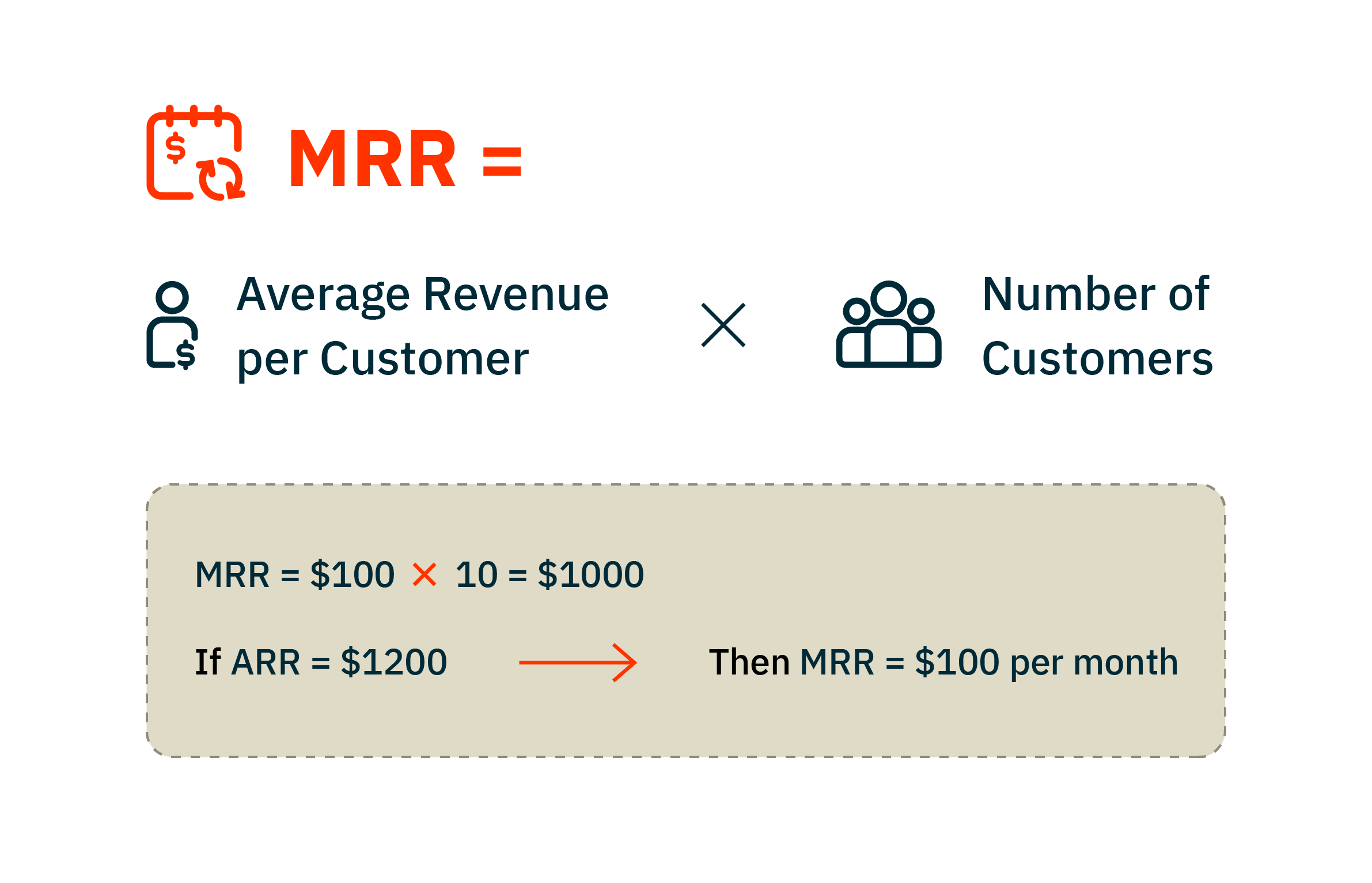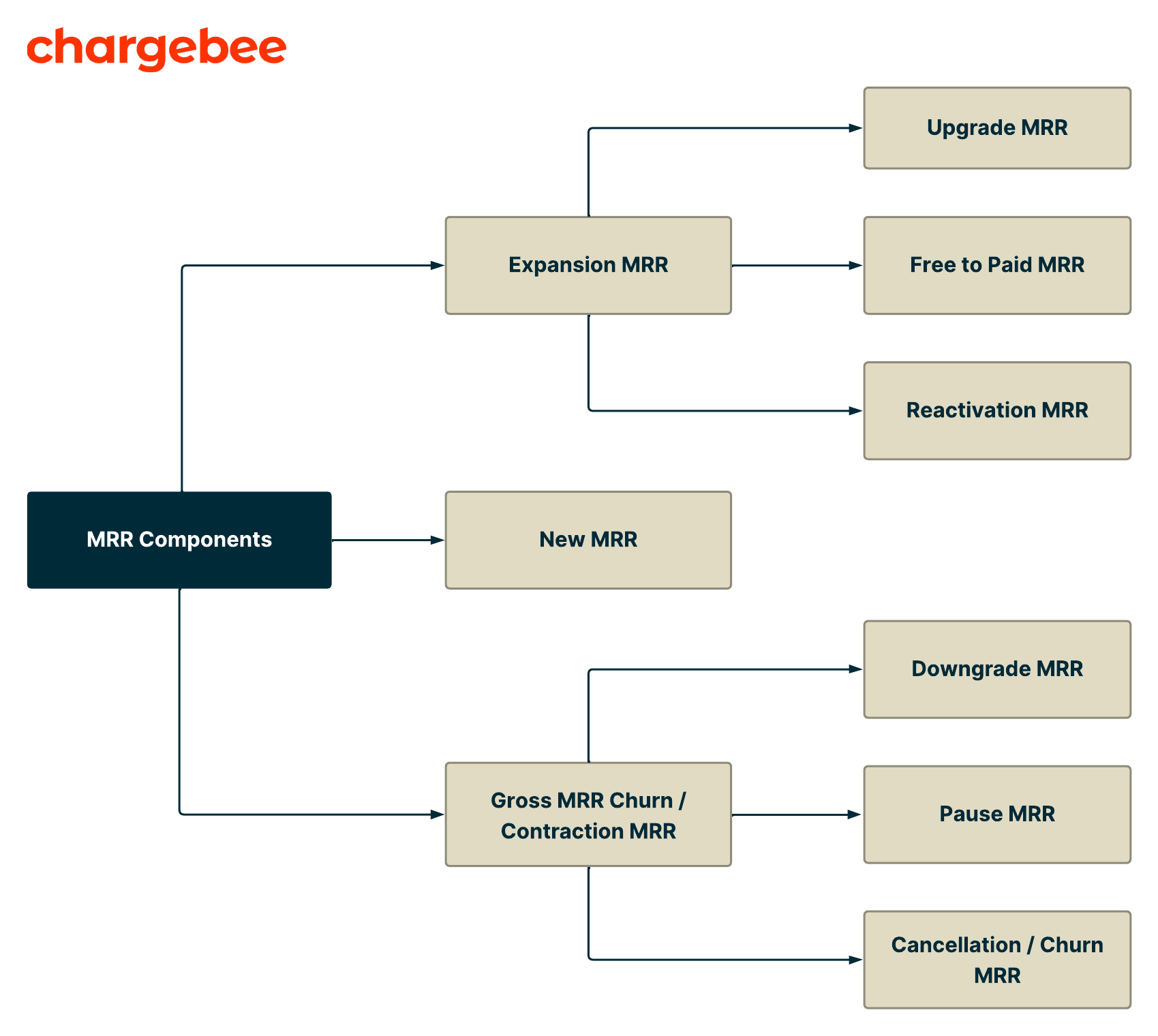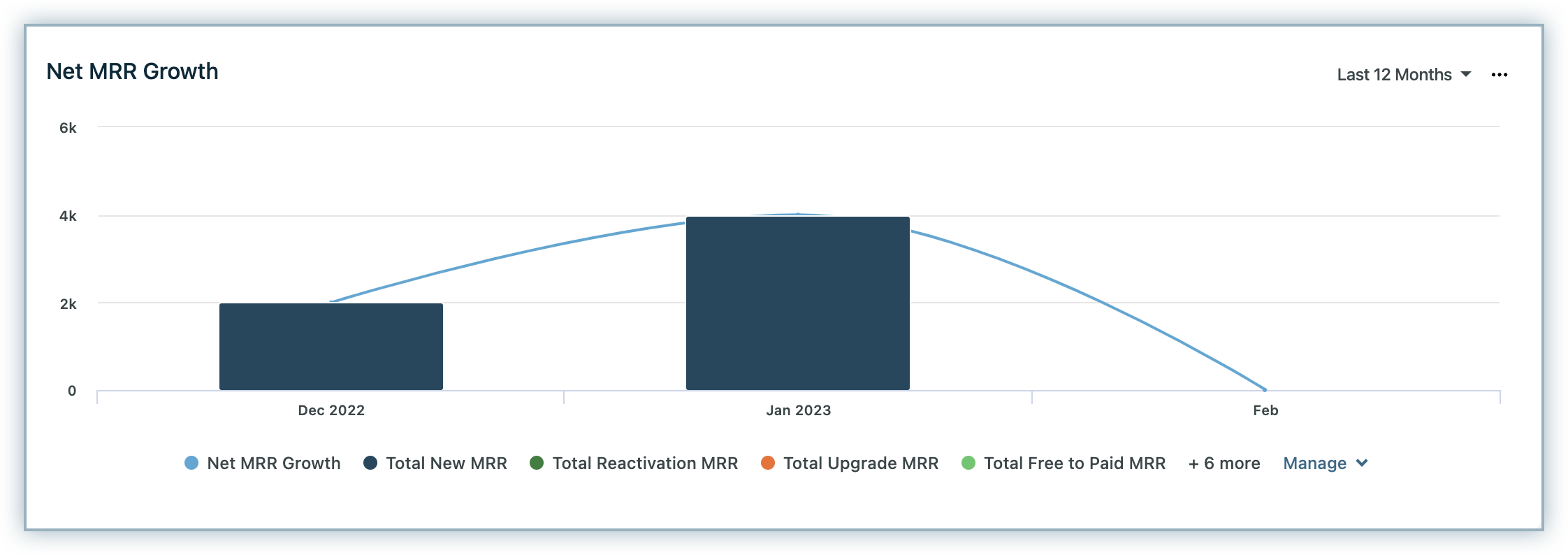Monthly Recurring Revenue (MRR) is the predictable recurring revenue earned from subscriptions in a specific period. As the name indicates, MRR is calculated for a monthly "duration". The MRR amount shown on the dashboard is a total of all your subscriptions' MRR.
For example,
In a monthly plan, if you have 10 customers each paying you $100 per month, then the MRR is $1,000.
In a yearly plan, if $1,200 is paid annually, then the MRR is normalized as $100 per month.

MRR is not the same as "payment received". It is a predictable recurring revenue from the current value of your subscribers. This makes MRR a prominent indicator of your business performance, since signups, upgrades, and churn will impact this metric.
If your business revolves around subscriptions, MRR will give a fair representation of the money your customers will be bringing in. It represents the health of your business, something an investor will look at before they make an investment. This makes MRR the most critical metric that you should strive to be growing every month.
Generally Accepted Accounting Principles (GAAP) is a traditional accounting methodology that refers to a common set of accounting principles and standards issued by the Financial Accounting Standards Board (FASB). GAAP metrics do not consider delayed profitability into account. These metrics rely on the sales that have already been made.
However, with the SaaS business, things are complex. Monthly Recurring Revenue (MRR) is not a reportable GAAP revenue and the revenue is not calculated based on past sales, but current and predicted subscriptions. MRR calculates an expected revenue number to clarify where your company's performance is headed and indicates what you can expect based on the existing customers, sales, upgrades, churn, and so on.
A number of metrics have been adopted across the SaaS industries to keep track of their business performance. Metrics such as Monthly Recurring Revenue (MRR), Annual Recurring Revenue (ARR), Committed Monthly Recurring Revenue (CMRR), Churn, and so on have become standard when measuring the performance of a SaaS company.
MRR is calculated from recurring subscription components such as plans, addons, coupons, and non-recurring components based on the settings configured in Chargebee. Subscriptions in free trials, setup fees, trial charges, and the amount charged towards taxes are not included. It is fairly straightforward when all the charges are simple recurring charges. But as a subscription business, you tend to have a mix of one-time and recurring charges for a customer and it helps to understand what is considered as part of MRR calculation and what is excluded, by default.
MRR calculated in Chargebee is at the subscription level. The Customer Insights tab allows you to view reports at a customer level (all the other dashboards displays reports at the subscription level). Learn more.
What is included in the MRR calculation?
Learn more on how to configure the flexible MRR components.
MRR takes into account all the Active and Non-Renewing Subscriptions. Subscriptions in dunning are considered Active until the dunning period ends. The associated MRR remains part of the total MRR calculation since the revenue is still expected to be recovered.
What is excluded in the MRR calculation?
Subscriptions in "Future" and "In Trial" status are not included in the calculation.
Example 1:
If you have 10 customers paying $50 per month, your MRR is 10* 50 = $500. If you acquire two more customers on a more expensive plan of $100 per month in the same period, your MRR increases to $700.
Example 2:
MRR is a forward-looking, point-in-time metric. Any mid-period calculation will reduce the MRR value to zero for that period.
For example, if a subscription having a monthly plan for $100 is canceled on the 17th of that month, then the MRR will be $100 from the 1st to the 16th, and the value drops to zero from the 17th onwards. Also, the MRR is considered to be zero for the entire month as the MRR for that particular month-end is zero.
While measuring MRR can be straightforward, this metric can be broken down to help you understand how your business is performing in terms of acquisition, retention, and scaling.
The following diagram shows the different MRR components calculated in Chargebee.

This is the new monthly recurring revenue earned from newly acquired subscriptions in a given period. This can be directly attributed to all your new customer acquisition strategies and helps mark out the channels that contribute to revenue.
New MRR = Total sum of MRR for all subscriptions that are active with MRR > 0 and have an activation date in a specific period.
This includes trial-to-active conversions as well as subscriptions directly activated with active status. It also includes first-time activations. Subsequent reactivations are considered part of Expansion MRR.
New MRR does not mean that it is the newly earned MRR from existing subscriptions. It means that the MRR is earned from the newly activated subscriptions. For example, if a subscription activated with zero MRR in the previous period generates MRR in the current period. This will have the Free to paid MRR for the current period and not the New MRR.
For example, If you activated 5 new subscriptions this month giving you revenues of $100, $200, $300, $400, and $500 respectively, your New MRR for the month would be $1500.
This is the additional MRR from all customers who have upgraded to a higher-priced plan from a lower-priced plan or purchased a recurring add-on. It's indicative of an increase in the subscription quantity or movement to a higher pricing plan. As customers upgrade, the MRR increases. Upgrade MRR gives you a fair representation of how well your product scales with the growth of your customers.
Upgrade MRR = Total sum of the MRR gained from all subscriptions that are active as of a specific period compared to their MRR in the previous period.
For example, if a subscription is moved from plan A (MRR $50) to plan B (MRR $150) then the Upgrade MRR would be $100.
If a customer downgrades the plan but adds an addon that is more than the plan downgrade amount, it is also an upgrade. For example, if a subscription moves from Plan A (MRR $50) to Plan C (MRR $25) and adds a recurring addon for $50, the Upgrade MRR will be $25.
When you have the right set of features in all your plans and are constantly adding valuable new features, it encourages your customers to upgrade. If this number is not increasing, you are probably offering too much value in the lower plans. And your customers don't have a reason to upgrade. You'll have to revisit your plans and pricing.
This is the monthly recurring revenue generated from subscriptions which are moved from free plans to paid plans. It also includes the revenue generated when subscriptions of paid plans move from a free period to a paid period.
Free to Paid MRR = Total sum of MRR gained from all subscriptions that are active as of a specific period, have non-zero MRR as of a specific period, and have a zero MRR in the previous period.
Example:
If a subscription is moved from plan A (free) to plan B (MRR $150), then the free-to-paid MRR would be $150. Also, if a subscription was on trial in the previous period and is now on a paid plan B with an MRR of $150, then the free-to-paid MRR would be $150.
Additional MRR from customers who had previously churned or canceled. Reactivation MRR is a component of expansion MRR. It is important for these customers to have contributed $0 to the MRR in the previous period (does not include users in free trials).
Reactivation MRR = Total sum of MRR gained from all subscriptions that were reactivated in a specific period.
For example, if a subscription canceled in the previous month is reactivated in plan B (MRR $150) then the reactivation MRR would be $150.
Reactivation MRR can indicate that your customers felt their needs were better met by a competitor but decided to come back for various reasons. It can also mean they no longer needed your product or service but saw it resurface again.
Expansion MRR is the amount of additional revenue coming from your existing subscriptions.
The following activities will contribute to the additional recurring revenue:
Expansion MRR = Total sum of Upgrade MRR, Free to paid MRR, Reactivation MRR as of a specific period
An increase in this number indicates that the revenue generated from your existing customer base is growing. This is great news to know that the business is growing without adding new customers, or without spending on acquiring new customers. It is recommended to keep the Expansion MRR higher than the Gross MRR Churn metric.
Often confused with Upgrade MRR, Expansion MRR also takes into account MRR contribution from reactivation of a previously canceled subscription and free-to-paid conversions. In contrast with Upgrade MRR, Expansion MRR also gives a deeper level of understanding of how well you are able to convert free customers to paid customers, and how often canceled subscribers return to you.
This is the other component that drives Contraction MRR. Downgrade MRR is the monthly recurring revenue lost from subscriptions that moved from an existing to a lower plan. This is the reduction in monthly recurring revenue caused by factors such as add-ons removed from subscriptions, a decrease in subscription quantity, and the recurring discounts you provide.
Downgrade MRR = Total sum of the MRR lost from all subscriptions which are active in the current period compared to their MRR in the previous period.
For example, if a subscription (customer) has moved from plan A (MRR $500) to plan B (MRR $100) then the Downgrade MRR would be $400.
Also, for a subscription where a customer has upgraded the plan but the discount or addon is removed from the plan, then it eventually results in a downgrade MRR. For example, if a subscription moves from Plan A (MRR $50) to Plan B (MRR $100) and removes an earlier added recurring addon 2 (MRR $100) then the Downgrade MRR will be $50.
High Downgrade MRR means customers are not finding enough value in their current plans for the price they pay. Hence, the downgrade. So when you see Downgrade MRR rising, make sure you talk to customers to understand the grievances and relay them back to the product. The eventual solution might be to add relevant high-value features to your higher subscription plans or to invest further in customer marketing and customer success initiatives.
This is the monthly recurring revenue of subscriptions that are in a paused state. Subscriptions placed on pause will not be accounted for Churn, hence your reports will be accurate and will reflect the right numbers.
A component in the calculation of Contraction MRR, Churn MRR, or Cancellation MRR takes into account the MRR lost due to canceled or churned subscriptions.
Cancellation MRR = Total sum of the MRR lost for all subscriptions which were cancelled in a specific period
For example, if 5 of your subscriptions with $100 MRR each got canceled this month, then your cancellation MRR would be $500.
Churn is useful in understanding how well your product stays relevant to your customers' needs. During the early stages of a subscription business, a high or a rising churn MRR or cancellation MRR may indicate poor product-market fit, while a similar trend during later stages may point towards a recent marketing campaign that brought in customers with the wrong promise.
Gross MRR Churn is the total reduction in MRR due to downgrade, pause, and subscription cancellation (or churn) compared to the previous period.
Gross MRR Churn = Total sum of Downgrade MRR, Cancellation MRR, Pause MRR as of a specific period
Gross MRR Churn helps you understand how well your business can retain customers and how well your product scales with your customers' growth.
This is the net increase or decrease in monthly recurring revenue during the period after taking into account all the New MRR, Expansion MRR, and Contraction MRR.
Net MRR Growth = Total sum of Expansion MRR, New MRR minus Gross MRR Churn

Your Net MRR Growth considers new revenue, expansions, and contractions. There are three keys to ensure overall profitability - minimize churn, drive upgrades from existing customers, and add new paying customers. It shows you how fast your business is growing. If you have your Net MRR growing at anything over 10-15% month on month (your revenue doubles every 6 months), you should consider that your business is growing much more effectively.
The Net MRR growth in a period will not exactly match the difference in the Total MRR between the current period and the previous period due to exchange rate fluctuations. This change will also be reported as a category in the Net MRR growth chart.
RevenueStory, being a subscription analytics platform, offers multiple reports that require working with the subscriptions' historical data. When a new merchant signs up with Chargebee with no subscription data, then the history of each subscription entry is captured right from the beginning. However, when a merchant signs up and imports their past subscriptions into Chargebee, RevenueStory will only be able to capture the history of subscriptions that happen from the initial sync time. To fix this gap, MRR History Builder is created in Chargebee.
The goal of MRR History Builder is to generate historical data for each subscription from its first activation date to the initial sync date. Historical data is captured by scanning the subscriptions' associated invoice line items imported into Chargebee.
MRR History generation is done only once for a data source after the initial sync is complete. Therefore, invoices that are imported after the initial sync will be ignored. To include these invoices, the data source on RevenueStory has to be reset and created again.
What happens when there is a plan/quantity change for historical subscriptions? Does RevenueStory capture it as an upgrade?
Yes, it does. RevenueStory captures the subscriptions' plan, MRR, and status historically from the imported invoices. Since upgrades/downgrades are critical changes in MRR, they are captured in the MRR historical data.
Consider the following scenarios:
Scenario 1:
There are three overlapping invoice periods for a subscription and let's see how the MRR history is captured in Chargebee:
MRR history will be captured as follows:
Scenario 2:
When a prorated invoice or an invoice with prorated line item is encountered, the entire invoice is rejected and the MRR from the next non-prorated invoices or next available invoice with non prorated line item is considered for the MRR calculations.
MRR history will be captured as follows:
When a subscription is extended beyond the plan cycle, is this considered in the MRR calculation?
MRR will not be calculated when a subscription is extended beyond the plan cycle.
MRR is calculated based on the standard billing period associated with the product(plan in this case), regardless of any changes or extensions made to individual subscriptions.
Example
A subscription has a yearly plan 1200$, and an extension of one month is provided.
The subscription billing period starts on 01 Jan 2023 and ends on 31 Dec 2023, with an extension to 31 Jan 2024.
The MRR will be 1200/12=100$ from Jan 2023 to Dec 2023. There will not be any MRR for Jan 2024.
What happens to MRR calculation if a subscription is deleted in Chargebee?
When a subscription is deleted, it is excluded from all metrics such as MRR, Downgrade MRR, and so on for historical and current data.
How does a backdated change affect MRR?
When a subscription undergoes a backdated change, the MRR for the corresponding period is adjusted retrospectively. For instance, if an active subscription is modified with a backdated change on 30th November, the MRR for November will be recalculated to incorporate the update.